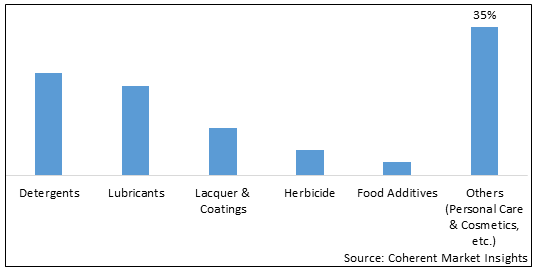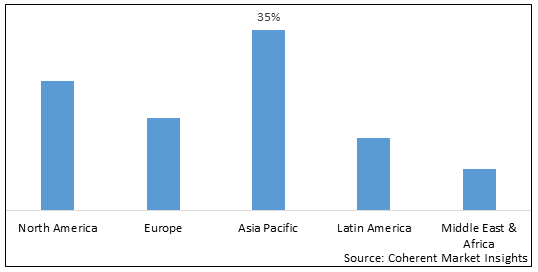Pelargonic Acid Market is estimated to be valued at USD 224.7 Mn in 2025 and is expected to reach USD 353.8 Mn in 2032, exhibiting a compound annual growth rate (CAGR) of 6.7% from 2025 to 2032.
Global Pelargonic Acid Market - Impact of Coronavirus (COVID-19) Pandemic
COVID-19 had a significant impact on the global pelargonic acid market. The imposition of lockdown across major countries, including China, the U.S., Italy, and India, has led to disruption in the supply chain across the globe. Furthermore, stringent containment measures imposed by the governments of various countries and preventive measures to control the impact of the Coronavirus outbreak have led to a significant restriction on transportation, leading to supply chain disruptions across the economies. Bio pesticides, such as pelargonic acid, find its applications in the production of herbicides, specialty chemicals, lubricants, food additives, and others across several industrial sectors.
Global Pelargonic Acid Market: Drivers
Pelargonic Acid Market Report Coverage
| Report Coverage | Details | ||
|---|---|---|---|
| Base Year: | 2024 | Market Size in 2025: | USD 224.7 Mn |
| Historical Data for: | 2020 To 2024 | Forecast Period: | 2025 To 2032 |
| Forecast Period 2025 to 2032 CAGR: | 6.7% | 2032 Value Projection: | USD 353.8 Mn |
| Geographies covered: |
|
||
| Segments covered: |
|
||
| Companies covered: |
Central Drug House, Croda International Plc., Emery Oleochemicals, Glentham Life Sciences Limited, Haihang Industry, Kunshan Odowell Co., Ltd, Matrica S.p.A, OQ Chemicals GmbH, Tokyo Chemical Industry Co., Ltd., and Zhengzhou Yibang Industry & Commerce Co., Ltd. |
||
| Growth Drivers: |
|
||
| Restraints & Challenges: |
|
||
Uncover macros and micros vetted on 75+ parameters: Get instant access to report
Global Pelargonic Acid Market: Restraints
Global Pelargonic Acid Market: Trends
Global Pelargonic Acid Market: Opportunities
Figure 1. Global Pelargonic Acid Market, By Application, 2025

To learn more about this report, Download Free Sample
Global Pelargonic Acid Market: Regional Analysis
Asia Pacific dominated the global pelargonic acid market in 2025, accounting for 35% share, in terms of revenue, followed by Europe, and North America, respectively. As a result of an increase in the demand for bio-based products in the agriculture industry, as well as product innovation. There has been increasing demand for lacquer & coatings in the construction sector, which is expected to drive demand for pelargonic acid. Lacquers are clear or colored coatings that provide a glossy finish to furniture and fixture surfaces. They are available with different sheen levels, ranging from high gloss to ultra-matte. It offers extremely hard finishes and is highly resistant to damage, particularly from acid, alkali, water, and abrasions. Coatings are used in general industry to protect the coated structure from corrosion, UV radiation, wear and tear, and to enhance the efficiency of the coated substance.
Figure 2. Global Pelargonic Acid Market, By Region, 2025

To learn more about this report, Download Free Sample
Global Pelargonic Acid Market: Recent Developments
Competitative Section
Key players operating in the global pelargonic acid market include Central Drug House, Croda International Plc., Emery Oleochemicals, Glentham Life Sciences Limited, Haihang Industry, Kunshan Odowell Co., Ltd, Matrica S.p.A, OQ Chemicals GmbH, Tokyo Chemical Industry Co., Ltd., and Zhengzhou Yibang Industry & Commerce Co., Ltd.
Global Pelargonic Acid Market: Key Development
In 2021, the global chemical company BASF announced the launch of a new pelargonic acid-based herbicide called Luximo. The herbicide is designed to control a wide range of weeds in various crops, including cereals, oilseed rape, and vegetables. Luximo is a selective herbicide that targets broadleaf weeds and can be used in both pre- and post-emergence applications.
*Definition: Pelargonic acid is a saturated, nine-carbon fatty acid found naturally as esters in the essential oil of pelargonium spp (perennial plants). It can also be extracted from plant tissues. Pelargonic acid, in combination with its salts and emulsifiers, is a nonselective herbicide that can be used in the garden or in agriculture across the world. They're utilized as contact burn down herbicides, which attack cell membranes, causing cell leakage and membrane acyl lipid breakdown in the process. Pelargonic acid is also used in the cosmetic industry to make esters, which are used in cosmetic and personal care products.
Share
Share
About Author
Vidyesh Swar is a seasoned Consultant with a diverse background in market research and business consulting. With over 6 years of experience, Vidyesh has established a strong reputation for his proficiency in market estimations, supplier landscape analysis, and market share assessments for tailored research solution. Using his deep industry knowledge and analytical skills, he provides valuable insights and strategic recommendations, enabling clients to make informed decisions and navigate complex business landscapes.
Missing comfort of reading report in your local language? Find your preferred language :
Transform your Strategy with Exclusive Trending Reports :
Frequently Asked Questions
Select a License Type
Joining thousands of companies around the world committed to making the Excellent Business Solutions.
View All Our Clients